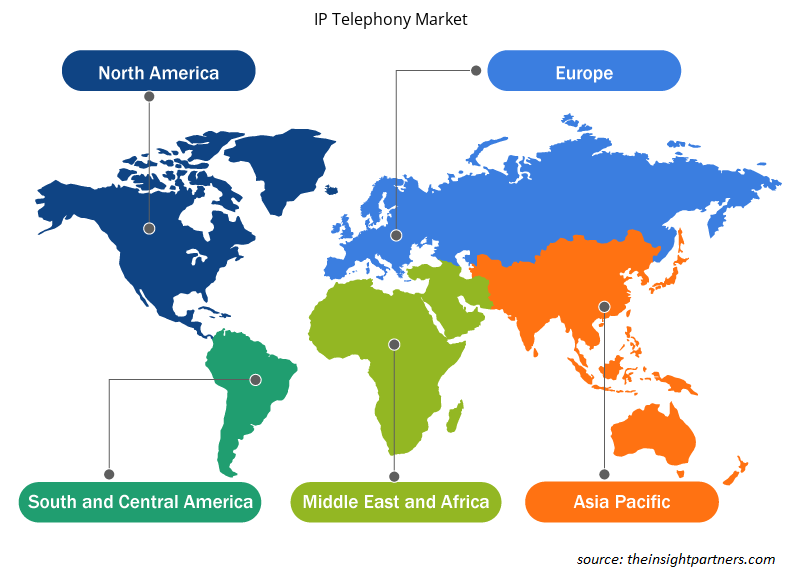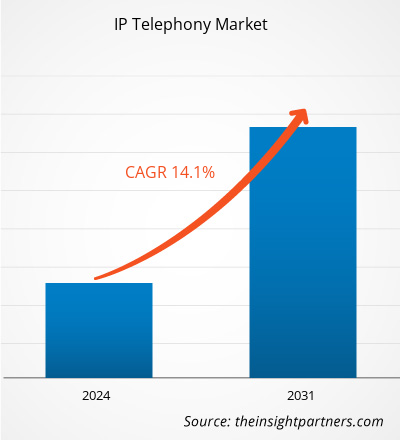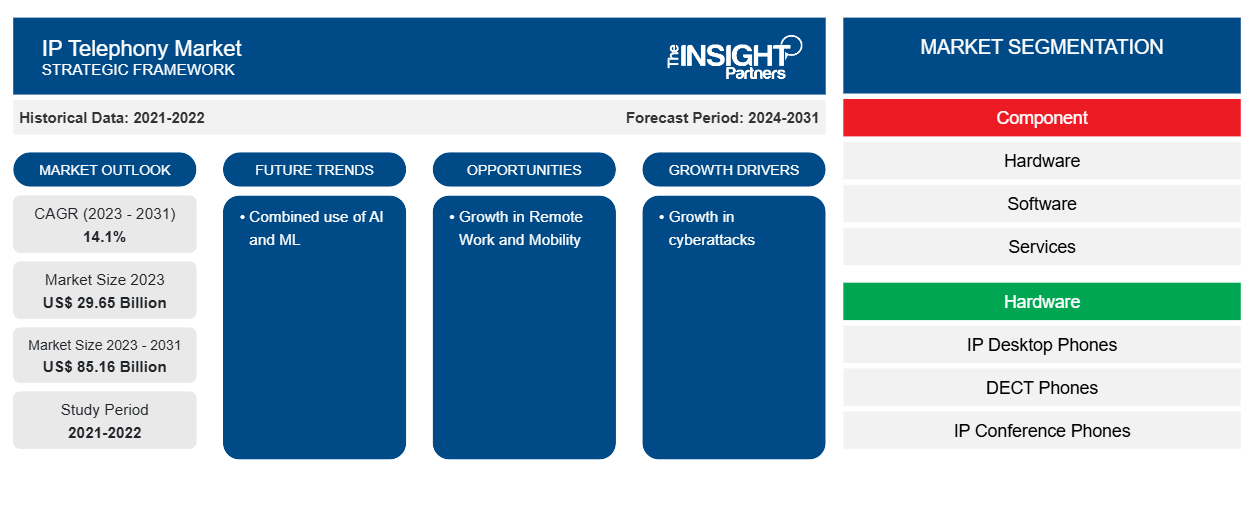Se proyecta que el tamaño del mercado de telefonía IP alcance los 85.160 millones de dólares en 2031, frente a los 29.650 millones de dólares en 2023. Se espera que el mercado de telefonía IP registre una CAGR del 14,1 % durante el período 2023-2031. La voz sobre IP (VoIP) es un servicio y una aplicación que se incluye en el ámbito de la telefonía IP. Es la transmisión de comunicaciones de voz a través de redes IP.
Análisis del mercado de telefonía IP
La telefonía con protocolo de Internet (IP) ofrece una variedad de servicios, como llamadas de voz, videollamadas, correo de voz, fax, mensajería instantánea (1M) y videoconferencias. La telefonía IP, a diferencia de VolP, a menudo ofrece más que solo funciones de voz. La telefonía IP beneficia a organizaciones de todos los tamaños al proporcionar una red combinada para funciones de teléfono e Internet. La telefonía IP ofrece costos más bajos, infraestructura más simple, escalabilidad y movilidad, lo que la hace atractiva para los usuarios finales.
Panorama del mercado de telefonía IP
La telefonía IP se refiere a cualquier sistema que se enmarca dentro de las telecomunicaciones basadas en Internet, incluyendo el fax y otras tecnologías. Utiliza una variedad de protocolos de código abierto para enviar datos desde el teléfono al proveedor de servicios. Las empresas están implementando rápidamente soluciones de telefonía IP debido a su portabilidad y rentabilidad. Además, los sistemas de telefonía IP son fáciles de usar, ofrecen tecnologías avanzadas y aumentan la productividad. Estos factores están impulsando la adopción de sistemas de telefonía IP. La telefonía IP agrega una nueva característica a los teléfonos comerciales y mejora la comunicación al brindar una solución rentable, lo que se considera un factor clave para el mercado mundial de telefonía IP. Los sistemas y hardware heredados existentes, como máquinas de fax , lectores de tarjetas de crédito y alarmas, se pueden vincular fácilmente con los sistemas de telefonía IP.
Personalice este informe según sus necesidades
Obtendrá personalización en cualquier informe, sin cargo, incluidas partes de este informe o análisis a nivel de país, paquete de datos de Excel, así como también grandes ofertas y descuentos para empresas emergentes y universidades.
-
Obtenga las principales tendencias clave del mercado de este informe.Esta muestra GRATUITA incluirá análisis de datos, desde tendencias del mercado hasta estimaciones y pronósticos.
Factores impulsores y oportunidades del mercado de telefonía IP
Aumento de ciberataques favorece al mercado
Los rápidos avances tecnológicos han provocado un aumento de las vulnerabilidades en los últimos años. Las empresas recurren cada vez más a los productos y servicios de telefonía IP a medida que los ciberataques se vuelven más comunes. IBM estima que el coste total de las violaciones de datos en las empresas será de aproximadamente 6 billones de dólares solo en 2021. Se espera que las cifras aumenten durante el período previsto. Por lo tanto, las empresas están implementando soluciones de telefonía IP para proteger los datos y prevenir las violaciones, lo que se espera que impulse la CAGR del mercado de telefonía IP durante el período previsto.cyberattacks become more common. IBM estimates that the total cost of data breaches in enterprises will be approximately US$ 6 trillion in 2021 alone. The numbers are expected to rise during the anticipated timeframe. Hence, businesses are deploying IP telephony solutions to protect data and prevent breaches, which is expected to boost the IP telephony market CAGR throughout the forecast period.
Aumento de la cultura del trabajo remoto
El uso cada vez mayor de dispositivos móviles y la creciente adopción de una cultura de trabajo remoto están impulsando la demanda de soluciones de telefonía IP adaptables y de rápida disponibilidad. Los empleados utilizan cada vez más aplicaciones de teléfonos inteligentes para realizar y recibir llamadas desde cualquier lugar. Además, la colaboración remota requiere comunicación con software de videoconferencia. Los proveedores de telefonía IP se están centrando en desarrollar soluciones que aborden estas necesidades en constante evolución.
Informe de mercado de telefonía IP Análisis de segmentación
Los segmentos clave que contribuyeron a la derivación del análisis del mercado de telefonía IP son componentes, hardware, servicio, tipo de instalación, tipo de empresa y usuarios finales.
- Según los componentes, el mercado de telefonía IP se divide en hardware, software y servicios.
- Por hardware, el mercado está segmentado en teléfonos de escritorio IP, teléfonos DECT y teléfonos de conferencia IP.
- Según el servicio, el mercado de telefonía IP se divide en instalación y mantenimiento y servicios profesionales.
- Según el tipo de instalación, el mercado de telefonía IP se segmenta en cableado e inalámbrico.
- Según el tamaño de la empresa, el mercado de telefonía IP se segmenta en pymes y grandes empresas.
- Según los usuarios finales, el mercado de telefonía IP está segmentado en organizaciones residenciales, corporativas y gubernamentales.
Análisis de la cuota de mercado de telefonía IP por geografía
El alcance geográfico del informe de mercado de telefonía IP se divide principalmente en cinco regiones: América del Norte, Asia Pacífico, Europa, Oriente Medio y África, y América del Sur y Central. Las causas implicadas se derivan de los aumentos globales en la adopción de aplicaciones de telefonía IP y el avance tecnológico. Estas aplicaciones a menudo se crean en ciertos sectores industriales, como BFSI, atención médica, comercio minorista, TI y telecomunicaciones. Además, se espera que el crecimiento de la región sea impulsado por el uso generalizado de servicios de telefonía IP, infraestructura de telecomunicaciones de vanguardia y el atractivo de la movilidad laboral.
Perspectivas regionales del mercado de telefonía IP
Los analistas de Insight Partners explicaron en detalle las tendencias y los factores regionales que influyen en el mercado de telefonía IP durante el período de pronóstico. Esta sección también analiza los segmentos y la geografía del mercado de telefonía IP en América del Norte, Europa, Asia Pacífico, Oriente Medio y África, y América del Sur y Central.

- Obtenga los datos regionales específicos para el mercado de telefonía IP
Alcance del informe sobre el mercado de telefonía IP
| Atributo del informe | Detalles |
|---|---|
| Tamaño del mercado en 2023 | US$ 29,65 mil millones |
| Tamaño del mercado en 2031 | US$ 85,16 mil millones |
| CAGR global (2023 - 2031) | 14,1% |
| Datos históricos | 2021-2022 |
| Período de pronóstico | 2024-2031 |
| Segmentos cubiertos |
Por componente
|
| Regiones y países cubiertos |
América del norte
|
| Líderes del mercado y perfiles de empresas clave |
|
Densidad de actores del mercado de telefonía IP: comprensión de su impacto en la dinámica empresarial
El mercado de telefonía IP está creciendo rápidamente, impulsado por la creciente demanda de los usuarios finales debido a factores como la evolución de las preferencias de los consumidores, los avances tecnológicos y una mayor conciencia de los beneficios del producto. A medida que aumenta la demanda, las empresas amplían sus ofertas, innovan para satisfacer las necesidades de los consumidores y aprovechan las tendencias emergentes, lo que impulsa aún más el crecimiento del mercado.
La densidad de actores del mercado se refiere a la distribución de las empresas o firmas que operan dentro de un mercado o industria en particular. Indica cuántos competidores (actores del mercado) están presentes en un espacio de mercado determinado en relación con su tamaño o valor total de mercado.
Las principales empresas que operan en el mercado de telefonía IP son:
- Compañía: Avaya Inc.
- Sistemas operativos de Cisco
- Comunicaciones Gigaset
- LG Electronics Inc.
- Corporación Mitel Networks
- Corporación Panasonic
Descargo de responsabilidad : Las empresas enumeradas anteriormente no están clasificadas en ningún orden particular.

- Obtenga una descripción general de los principales actores clave del mercado de telefonía IP
Noticias y desarrollos recientes del mercado de telefonía IP
El mercado de telefonía IP se evalúa mediante la recopilación de datos cualitativos y cuantitativos a partir de investigaciones primarias y secundarias, que incluyen importantes publicaciones corporativas, datos de asociaciones y bases de datos. A continuación, se enumeran algunos de los avances en el mercado de telefonía IP:
- Broadvoice, proveedor de servicios de voz alojados, comunicaciones unificadas y trunking SIP, ganó el premio al Producto de telefonía por Internet del año 2022. Durante los últimos 23 años, el premio ha honrado y reconocido los productos y servicios de comunicación VoIP e IP.
(Fuente: Broadvoice, comunicado de prensa, marzo de 2022)
- Pure IP ofrece comunicaciones de voz globales para empresas. Ahora se puede acceder a ellas a través del sistema Zoom Phone Provider Exchange. Los clientes tendrán mayor libertad con este programa. Conservará Pure IP mientras utiliza su red de telecomunicaciones en otros lugares.
(Fuente: Pure IP, nota de prensa, abril de 2023)
Informe sobre el mercado de telefonía IP: cobertura y resultados
El informe "Tamaño y pronóstico del mercado de telefonía IP (2021-2031)" proporciona un análisis detallado del mercado que cubre las siguientes áreas:
- Tamaño del mercado de telefonía IP y pronóstico a nivel global, regional y nacional para todos los segmentos clave del mercado cubiertos bajo el alcance
- Tendencias del mercado de telefonía IP, así como dinámicas del mercado, como impulsores, restricciones y oportunidades clave
- Análisis detallado de las cinco fuerzas de Porter y PEST y FODA
- Análisis del mercado de telefonía IP que abarca las tendencias clave del mercado, el marco global y regional, los principales actores, las regulaciones y los desarrollos recientes del mercado
- Panorama de la industria y análisis de la competencia que abarca la concentración del mercado, análisis de mapas de calor, actores destacados y desarrollos recientes para el mercado de telefonía IP
- Perfiles detallados de empresas
- Análisis histórico (2 años), año base, pronóstico (7 años) con CAGR
- Análisis PEST y FODA
- Tamaño del mercado, valor/volumen: global, regional y nacional
- Industria y panorama competitivo
- Conjunto de datos de Excel
Informes recientes
Testimonios
Razón para comprar
- Toma de decisiones informada
- Comprensión de la dinámica del mercado
- Análisis competitivo
- Información sobre clientes
- Pronósticos del mercado
- Mitigación de riesgos
- Planificación estratégica
- Justificación de la inversión
- Identificación de mercados emergentes
- Mejora de las estrategias de marketing
- Impulso de la eficiencia operativa
- Alineación con las tendencias regulatorias























 Obtenga una muestra gratuita para - Mercado de telefonía IP
Obtenga una muestra gratuita para - Mercado de telefonía IP